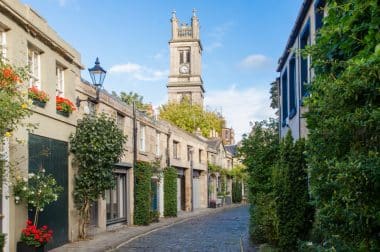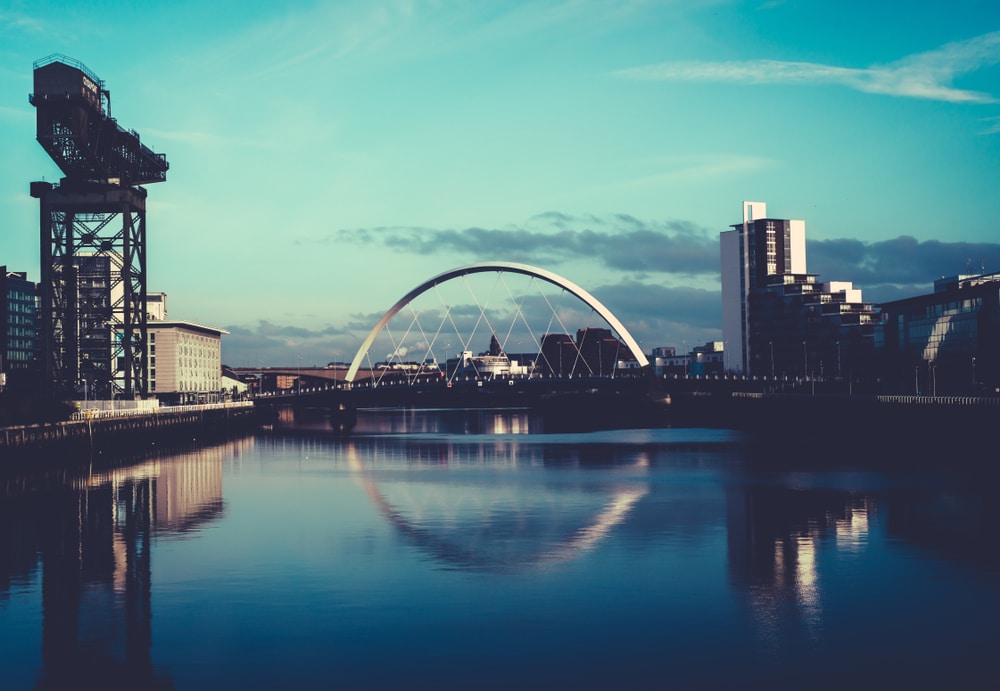A certain Sir Hugh Munro actually counted them in 1891 – the mountains of Scotland that are higher than 914.4 meters. 914.4 meters because this corresponds to the measurement of exactly three thousand feet. And because this was hard work, the mountains have been called “Munros” in honor of Sir Hugh Munro ever since. They are appreciated by mountain hikers not only in Scotland and some of them go into raptures during their tour. Especially in the most remote landscape in Europe, the Isle of Skye with its twelve “Munros”. And if you are good on foot and want to go higher, you should go to the more demanding “Corbetts” or even the strenuous “Grahams”. And at the foot of all these hills and mountains lie the picturesque emerald green lakes, some of which have been the scene of historical battles. Scotland is a refuge for people who hope for the great scenic cinema on their holiday.

Scotland’s light sometimes has dramatic features – when the sky is not opening its floodgates. Anyone who spends a few days in the highlands probably stores the images they have taken in there for a lifetime. This is a region where the ever-changing weather alone creates a certain amount of excitement among holidaymakers. When the rays of the sun make their way through the clouds, the landscape also shines, which previously showed its rather rough side and now suddenly comes across as gentle and mild.
When the Lord God still had a few stones left after creation, he is said to have created this land. So says a legend of Scotland, and those who live here love their homeland fervently and regard hiking in the mountains as a pleasure and not as torture. In their advertising brochures, tourism managers often praise Scotland as “the last wilderness in Europe”. There is more than just a trace of truth in this. High up in the northwest of the British Isles, many paths lead to happiness. Many of these paths are quite narrow, and you have to drive them on the left side without exception if you are traveling by car.

When you talk about Scotland, clichés always come to mind. There are the kilts made of coarse checked fabric, of which the world is puzzling over what the Scots wear underneath. There are the sounds of the bagpipes, which do not please everyone’s ear. There is, of course, whisky, which has a very special meaning here. There is the fog, which often conjures up an almost mystical atmosphere. And there is the Loch Ness monster, which some actually claim to have seen and of which scientists still insistently claim that such a creature does not exist. This encouraged a Scottish brewery to offer 500,000 pounds for catching the mythical creature. Be that as it may: Loch Ness is worth a visit even without “Nessie”.
The ancestral home of the Galloway cattle presents itself in the light of the rising sun in an almost extraterrestrial beauty. It is the Galloway Valley in the southeast of Scotland. In its neighbourhood there are numerous castles, many of which have retained their photogenic charm in this unique environment even as ruins. The small fishing villages on the coasts show their most beautiful side because they have recently spruced themselves up. And their pubs are more than just drinking rooms. They are the traditional meeting place of the population and, of course, a popular news exchange.
Popular Glasgow City Breaks
Edinburgh is both the pride of Scotland and the testimony of an interesting history. Ingenious architects have erected a monument for themselves here – including on Charlotte Square, one of the most beautiful squares in Europe. A stroll through Edinburgh, which is so different from bustling Glasgow, is a walk on historic ground. Where the magic around Harry Potter began, many authors were inspired to write their novels. Inverness, the “capital of the Highlands”, also has some pretty spots to offer.
Scotland’s largest cities
-

Elegant Georgian and Victorian terraced houses in Stockbridge, Image: Doubleclix / shutterstock Glasgow: With more than 600,000 inhabitants, Glasgow is the largest city in Scotland and the fourth largest in the United Kingdom. The city is known for its cultural diversity, architecture, and rich music scene.
- Edinburgh: The capital of Scotland is the second largest city in the country and is home to the Scottish Parliament and the famous Edinburgh Castle. The city has about 540,000 inhabitants.
- Aberdeen: Aberdeen is Scotland’s third largest city with about 200,000 inhabitants. It is an important industrial location, especially for the oil and gas industry in the North Sea.
- Dundee: Dundee is located on the east coast of Scotland and has around 150,000 inhabitants. The city is known for its university and its role in the video game industry.
- Inverness: As the capital of the Highlands, Inverness is the largest city in the north of Scotland. It has a population of about 65,000 and is a popular destination for tourists exploring the surrounding countryside.
- Stirling: Stirling is located near the geographical center of Scotland and has about 50,000 inhabitants. The city is known for its historical heritage, including Stirling Castle.
- Perth: Perth is a city of around 50,000 people and is located on the banks of the River Tay. It is an important shopping and trading city.
- St. Andrews: St. Andrews is a small town of about 17,000 people and is famous for its historic university and the famous golf course where golf was invented.
Top attractions in Scotland
- Edinburgh Castle: This majestic castle towers over the capital city of Edinburgh and is one of Scotland’s most recognizable sights. Visitors can explore the history of the castle and enjoy the breathtaking views of the city.
- The Royal Mile: This historic street stretches from Edinburgh Castle to Holyrood Palace and is lined with shops, restaurants, and historic buildings.
- Loch Ness: The famous loch in the Scottish Highlands is known not only for its natural beauty, but also for the fabled monster that is said to live in its depths.
- The Isle of Skye: This stunning island in the Inner Hebrides offers spectacular scenery, including steep cliffs, verdant valleys, and quaint fishing villages.
- St. Andrews: This historic town on the east coast is known for its university, famous golf course, and charming old town.
- The Cairngorms: A haven for outdoor enthusiasts, this massif offers hiking, skiing, mountain biking and more.
- The Orkney Islands: This group of islands in the north of Scotland is rich in archaeological sites, including the famous Stone Age settlements of Skara Brae.
- The Scotch whisky distilleries: Scotland is known worldwide for its whisky. Visitors can visit various distilleries and discover the diversity of this noble drink.
- The West Highland Way: This famous long-distance hiking trail stretches 150 kilometres from Glasgow to Fort William and offers spectacular views of the Scottish countryside.
- The Wallace Monument: This imposing monument near Stirling commemorates Scotland’s national hero William Wallace and offers great views of the surrounding countryside.
Facts about Scotland
- Part of the United Kingdom: Scotland is a part of the United Kingdom that forms the British nation along with England, Wales , and Northern Ireland.
- Edinburgh and Glasgow: The two largest cities in Scotland are Edinburgh, the capital, and Glasgow. Both cities have their own unique characters and are cultural hubs.
- Rich history: Scotland has a long and storied history, ranging from Celtic tribes to the Scottish kings and the famous struggle for independence under William Wallace and Robert the Bruce.
- Whisky: Scotland is world-famous for its Scotch whisky. There are more than 120 active distilleries across the country, and Scotch whisky is exported all over the world.
- Kilts and bagpipes: Scotland is famous for its traditional clothing, the kilt, and the characteristic musical instrument, the bagpipes.
- Lochs and mountains: Scotland is known for its stunning scenery, including the Scottish Highlands, numerous lochs (lochs) such as Loch Ness, and impressive mountains such as Ben Nevis, the highest mountain in the United Kingdom.
- Edinburgh Castle: Edinburgh Castle is one of Scotland’s most visited attractions and towers majestically over the city. It houses the Scottish Crown Jewels.
- Independent education: Scotland has its own education system and differs in some areas from that of England, Wales and Northern Ireland.
- Haggis: Haggis is a traditional Scottish dish made from offal, oats and spices. It’s often served at the Burns Supper, a feast in celebration of poet Robert Burns.
- Gaelic language: Scottish Gaelic is one of the official languages of Scotland, along with English. It is spoken in some parts of the country and has a rich cultural tradition.
- Edinburgh Festival Fringe: The Edinburgh Festival Fringe is the largest arts festival in the world, attracting artists and visitors from all over the world.
- Folklore and legends: Scotland is rich in folklore and legends, including the story of Loch Ness and its alleged sea monster, the Nessie.
- Sports: Scotland is proud of its sporting traditions, especially in football and rugby. The country’s national drink is Irn-Bru, a popular soft drink.
Travel information Scotland
| Capital | Edinburgh |
|---|---|
| Form of government | Parliamentary monarchy decentralised parliament within the parliamentary monarchy |
| Currency | Pound Sterling (GBP) |
| Area | approx. 77,910 km² |
| Population | approx. 5,347,600 (2014) |
| Languages | English |
| Electricity grid | 230 volts, 50 Hz |
| Area code | +44 |
| Time zone | UTC±0 GMT UTC+1 WESZ |


